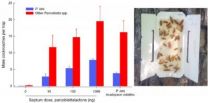(Press-News.org) A 125-year debate on how nitrogen-fixing bacteria are able to breach the cell walls of legumes has been settled. A paper to be published on Monday by John Innes Centre scientists reports that plants themselves allow bacteria in.
Once inside the right cells, these bacteria take nitrogen from the air and supply it to legumes in a form they can use, ammonia. Whether the bacteria breach the cell walls by producing enzymes that degrade it, or the plant does the work for them, has been contested since an 1887 paper in which the importance of the breach was first recognised.
"Our results are so clear we can unequivocally say that the plant supplies enzymes to break down its own cell walls and allow bacteria access," said Professor Allan Downie, lead author from the John Innes Centre, which is strategically funded by BBSRC.
The findings form part of research at JIC to fully understand the symbiosis that enables legumes to be the largest producers of natural nitrogen fertilizer in agriculture. Manufacturing nitrogen fertilisers for non-legume crops uses more fossil fuels than any other agricultural process. Once they have been applied, they release nitrous oxide, a greenhouse gas about 300 times more powerful than carbon dioxide.
Legumes bypass both problems via their symbiosis with rhizobial bacteria from soil. The ultimate aim is to enable non-legumes, and possibly even cereals such as wheat and rice, to develop the symbiosis and source their own nitrogen from the air like legumes.
"The fact that legumes themselves call the shots is a great finding but it also shows the complexity of the challenge to try to transfer the process to non-legumes," said Downie.
Plants give rhizobial bacteria a pass, but only allow a controlled invasion, not access all areas.
A plant cell wall is hard to penetrate, constructed from carbohydrates including pectin. It is like a room with no doors or windows. Rhizobial bacteria signal to the legume that they are there and the plant produces pectate lyase, an enzyme that breaks down pectin and allows rhizobia through one wall.
But this is not an open door for pathogenic bacteria and there are strict controls on entry.
The bacteria induce the plant to build a tunnel through to the next cell wall and the next until the bacteria reach the root where they will reside. As they grow along the tunnel and from wall to wall, they are not allowed beyond the tunnel's confines, ensuring the plant guards itself from them taking advantage. The tunnel also provides a barrier against rogue bacteria getting into plant cells disguised as rhizobia.
When the rhizobia reach the right type of cell, they are allowed to break out of the tunnel. The plant forms nodules on its roots to house the bacteria, from where they convert atmospheric nitrogen for the plant. The plant takes this essential nutrient to the leaves where it promotes growth and photosynthesis.
"There are two major challenges to understanding how plants promote nitrogen fixation," said Downie.
"Firstly, how does the plant make the nodules that contain cells to which the bacteria can be delivered, and secondly how do the bacteria get into these nodule cells?"
The findings published in PNAS contribute to understanding the latter.
"There will be many more hurdles to overcome, but our findings reveal a key step in the development of nitrogen fixation symbioses."
###
Contacts
JIC Press Office
Zoe Dunford, Tel: 01603-255111, email: zoe.dunford@nbi.ac.uk
Andrew Chapple, Tel: 01603-251490, email: andrew.chapple@nbi.ac.uk
Reference: Legume pectate lyase required for root infection by rhizobia
DOI: www.pnas.org/cgi/doi/10.1073/pnas.1113992109
NOTES TO EDITORS
Funding
The work was supported by Grant E017045/1, a Grant-in-Aid from the Biotechnology and Biological Research Council, and the John Innes Foundation.
About the John Innes Centre:
The John Innes Centre, http://www.jic.ac.uk, is a world-leading research centre based on the Norwich Research Park http://www.nrp.org.uk. The JIC's mission is to generate knowledge of plants and microbes through innovative research, to train scientists for the future, and to apply its knowledge to benefit agriculture, human health and well-being, and the environment. JIC delivers world class bioscience outcomes leading to wealth and job creation, and generating high returns for the UK economy. JIC is one of eight institutes that receive strategic funding from the Biotechnology and Biological Sciences Research Council and received a total of £28.4M investment in 2010-11.
About BBSRC
BBSRC invests in world-class bioscience research and training on behalf of the UK public. Our aim is to further scientific knowledge to promote economic growth, wealth and job creation and to improve quality of life in the UK and beyond.
Funded by Government, and with an annual budget of around £445M, we support research and training in universities and strategically funded institutes. BBSRC research and the people we fund are helping society to meet major challenges, including food security, green energy and healthier, longer lives. Our investments underpin important UK economic sectors, such as farming, food, industrial biotechnology and pharmaceuticals.
For more information about BBSRC, our science and our impact see: http://www.bbsrc.ac.uk
For more information about BBSRC strategically funded institutes see: http://www.bbsrc.ac.uk/institutes
Legumes give nitrogen-supplying bacteria special access pass
A 125-year debate on how nitrogen-fixing bacteria are able to breach the cell walls of legumes has been settled
2011-12-19
ELSE PRESS RELEASES FROM THIS DATE:
Researchers find misinformation about emergency contraception common in low-income neighborhoods
2011-12-19
Boston – Researchers from Boston Medical Center (BMC) and Boston University School of Medicine (BUSM) have found that in low-income neighborhoods, misinformation about access to emergency contraception is a common occurrence. These findings appear as a research letter in the Dec. 19 on-line issue of the Journal of the American Medical Association.
In 2009, the U.S. Food and Drug Administration facilitated access to emergency contraception among adolescents by making it available over-the-counter to individuals age 17 years and older.
From September to December 2010, ...
Targeting EETs to treat cardiovascular disease may prove a double-edged sword
2011-12-19
Boston, Mass. – A group of small molecules called EETs – currently under scrutiny as possible treatment targets for a host of cardiovascular diseases – may also drive the growth and spread of cancer, according to researchers at the Dana-Farber/Children's Hospital Cancer Center (DF/CHCC) and other institutions. Their findings also raise the possibility that drugs that block EETs could serve as a new avenue for cancer treatment.
This study, led by Dipak Panigrahy, MD, of DF/CHCC and the Vascular Biology Program at Children's Hospital Boston, appeared online December 19 ...
Cockroach hookup signal could benefit endangered woodpecker
2011-12-19
A North Carolina State University discovery of the unique chemical composition of a cockroach signal – a "Let's hook up" sex pheromone emitted by certain female wood cockroaches to entice potential mates – could have far-ranging benefits, including improved conservation of an endangered woodpecker.
Dr. Coby Schal, Blanton J. Whitmire Professor of Entomology at NC State and the corresponding author of a paper describing the discovery, says that the study, published the week of Dec. 19 in Proceedings of the National Academy of Sciences, advances the knowledge of fundamental ...
Wayne State study finds soybean compounds enhances effects of cancer radiotherapy
2011-12-19
Detroit - A Wayne State University researcher has shown that compounds found in soybeans can make radiation treatment of lung cancer tumors more effective while helping to preserve normal tissue.
A team led by Gilda Hillman, Ph.D., professor of radiation oncology at Wayne State University's School of Medicine and the Barbara Ann Karmanos Cancer Institute, had shown previously that soy isoflavones, a natural, nontoxic component of soybeans, increase the ability of radiation to kill cancer cells in prostate tumors by blocking DNA repair mechanisms and molecular survival ...
Infrared technology for measuring the effect of fire on materials
2011-12-19
This press release is available in Spanish.
The main problem associated with measuring the effects of fire on materials lies in the temperature of the flames, which reaches over 1000 ºC and can obscure the actual temperature of the material. In addition, there is the problem of the high concentration of gasses (CO2, H2O and others), which makes it difficult to obtain clear images of the sample being subjected to fire. In order to solve this problem, the UC3M scientists who developed this method used a measurement that utilizes the infrared spectrum. "To do this, ...
First aid after tick bites
2011-12-19
This press release is available in German.For years, Mrs. S. suffered from joint pain and headaches. After an odyssey through doctors' waiting rooms, one doctor diagnosed Lyme borreliosis – an infectious disease transmitted by ticks. With its bite, the parasite introduced bacteria that then spread throughout the entire body. Mrs. S. is not alone – very often, the disease is recognized too late or not at all, or is not properly treated. Doctors are provided with no clues if the characteristic redness around the bite area is missing. Left untreated, Lyme borreliosis can cause ...
Ultra-compact dwarf galaxies are bright star clusters
2011-12-19
Astronomy & Astrophysics is publishing the results of a detailed investigation of how many 'ultra-compact dwarf galaxies' (UCDs) can be found in nearby galaxy clusters. UCDs were recognized as a populous and potentially distinct class of stellar systems about a decade ago. But they are still mysterious objects that are characterized by a compact morphology (30-300 light-years in size) and high masses (more than one million solar masses). More generally, their properties (e.g., their size, shape, or luminosity) are similar to those of both star clusters and dwarf galaxies. ...
Article Catalog, a New Article Directory, Offers Free Search Engine Optimization Opportunities for All
2011-12-19
Article Catalog, a new article directory, launched today, Thursday, 15 December, 2011.
The site offers users free, unlimited submissions of articles to its directory. Articles are categorized by industry and have to be a minimum of 300 words and a maximum of 2000 words in length. The site is available to companies worldwide and is visually appealing, and has an easy-to-use, straightforward login system and an aesthetically pleasing interface design.
"The idea behind launching this directory was to offer another article marketing opportunity for companies looking ...
Many Business Supplies & Services Consolidated by Grand Rapids, MI Vendor
2011-12-19
Grand Rapids, Michigan's small business community has many vendors to turn to for business supplies and services such as printing, direct marketing and merchant services, but until recently, no vendor sought to simplify small business operations by offering all these services and supplies under one roof. Dodson Group started operations in 1998 providing office supplies and direct mail marketing solutions to automotive dealerships, but as their client base increased, Dodson Group began offering supplemental services to businesses in other industries.
Today, the Grand ...
German research team targets 'at risk' data on biodiversity
2011-12-19
Copenhagen, Denmark – A new German-based project is setting out to rescue biodiversity data at risk of being lost, because they are not integrated in institutional databases, are kept in outdated digital storage systems, or are not properly documented.
The project, run by the Botanic Garden and Botanical Museum Berlin-Dahlem, provides a good example for a GBIF recommendation to establish hosting centres for biodiversity data. This is one of a set of data management recommendations just published by GBIF.
The team behind the German project called reBiND (http://rebind.bgbm.org/), ...
LAST 30 PRESS RELEASES:
Practical education: Clinical scenario-based program development
The impact of family dynamics on eating behaviour – how going home for Christmas can change how you eat
Tracing the quick synthesis of an industrially important catalyst
New software sheds light on cancer’s hidden genetic networks
UT Health San Antonio awarded $3 million in CPRIT grants to bolster cancer research and prevention efforts in South Texas
Third symposium spotlights global challenge of new contaminants in China’s fight against pollution
From straw to soil harmony: International team reveals how biochar supercharges carbon-smart farming
Myeloma: How AI is redrawing the map of cancer care
Manhattan E. Charurat, Ph.D., MHS invested as the Homer and Martha Gudelsky Distinguished Professor in Medicine at the University of Maryland School of Medicine
Insilico Medicine’s Pharma.AI Q4 Winter Launch Recap: Revolutionizing drug discovery with cutting-edge AI innovations, accelerating the path to pharmaceutical superintelligence
Nanoplastics have diet-dependent impacts on digestive system health
Brain neuron death occurs throughout life and increases with age, a natural human protein drug may halt neuron death in Alzheimer’s disease
SPIE and CLP announce the recipients of the 2025 Advanced Photonics Young Innovator Award
Lessons from the Caldor Fire’s Christmas Valley ‘Miracle’
Ant societies rose by trading individual protection for collective power
Research reveals how ancient viral DNA shapes early embryonic development
A molecular gatekeeper that controls protein synthesis
New ‘cloaking device’ concept to shield sensitive tech from magnetic fields
Researchers show impact of mountain building and climate change on alpine biodiversity
Study models the transition from Neanderthals to modern humans in Europe
University of Phoenix College of Doctoral Studies releases white paper on AI-driven skilling to reduce burnout and restore worker autonomy
AIs fail at the game of visual “telephone”
The levers for a sustainable food system
Potential changes in US homelessness by ending federal support for housing first programs
Vulnerability of large language models to prompt injection when providing medical advice
Researchers develop new system for high-energy-density, long-life, multi-electron transfer bromine-based flow batteries
Ending federal support for housing first programs could increase U.S. homelessness by 5% in one year, new JAMA study finds
New research uncovers molecular ‘safety switch’ shielding cancers from immune attack
Bacteria resisting viral infection can still sink carbon to ocean floor
Younger biological age may increase depression risk in older women during COVID-19
[Press-News.org] Legumes give nitrogen-supplying bacteria special access passA 125-year debate on how nitrogen-fixing bacteria are able to breach the cell walls of legumes has been settled


